 |
| at Glencairn |
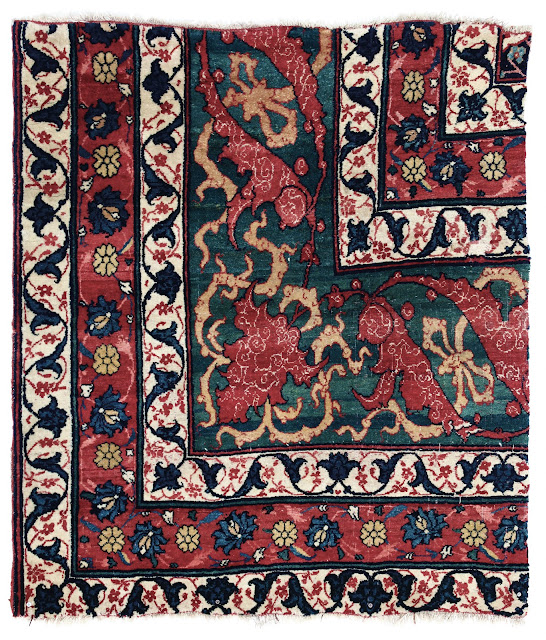 |
| The classic Garrus border arrangement-Cambi 12.12.2018-19 |
This presentation covers the Garrus carpets of Bijar County in Western Iran,an area populated chiefly by Kurds,but with a significant minority of Azeri Turks.A core group of arabesque carpets are signed and dated, thus enabling a rare localisation (18).At least two carpets,however,have dates which have been tampered with, so the inscriptions as a whole should be treated cautiously.The defining border employed derives from a member of the Salting Group now kept in Tehran, a fork-leaf rinceau with cloudbands ending in a tied-ribbon.A version of the Tehran rug,once in the Dole Collection, appeared at the V.Blau auction at Sothebys in 2006, and was later advertised by the American dealer and Bijar Impresario John Collins. It appears to be a faithfull copy and is knotted on a silk foundation, as is the original. Dedicated to the Amir Kabir, the date of 1849 seems not to have been questioned or investigated, which considering its purchase price of $144,000 is not surprising.According to Donald Wilber, who investigated such things, it is the earliest dated Garrus carpet. The dedication is presumably enclosed in two boxes in the middle border area usually reserved for talismanic Kufi.The Garrus version lacks the certainty apparent in the weave of the Salting rug,which has a pendant in a piece once in London.Both of these rugs introduce the white-ground arabesque minor guard,also a mainstay of Garrus weaving.The Tehran Salting indicates a sophisticated choice for a copy.However,there are no hard facts available for this carpet, which came from the Ardabil Shrine (2).
 |
| 2- Salting Tehran and V.Blau copy |
 |
| 3-Salting carpet,London |
Prayer rugs are anyway a scarcity from the Garrus group:only one other has been recorded here in a more rural style( 73a).But two medallion carpets with the Salting design are known (4).A carpet once with Emir bears the improbable date of 1802/03,presumably altered from 1902, with a lacklustre field and a relaxed style of weaving on an all silk foundation. As many of these rugs have been tampered with in the same way it seems likely they were at one time in one place,with one owner.Others may well have been backdated during production.A second medallion rug, at Schuler in 2019 and last seen with Mollaian, has a more professional look to it. Many of these carpets have a border which modulates between green or blue-green.Yet another fragment was at the Bernheimer Sale(5).
 |
| 4 |
 |
| 5 |
The iconic arabesque carpets have attained a similar status as the Star Kazak and Salor carpet groups, and are amongst the outstanding 19th century Iranian carpets. Inspired by a group of Vase carpets, they can be traced back to one particular example which survives only as a battered fragment.The carpet is somewhat simpler than the grander models such as the Bernheimer fragment or the fragment in the MAK,but its simplicity made it easier to copy.It first appeared at Sothebys in 1976 as a complete patchwork, apparently issuing from the Remarque/Goddard Collection in Ascona. Yet it failed to sell,its merits going unnoticed.Later the fragment spent time in the Wher Collection and with Eberhart Herrmann.The right hand side was separated and loaned to the MET.A further fragment of border which presumably "fell off" was purchased by the painter Purrmann, an avid collector of classical fragments.The larger left-hand piece was re-offered at Christies in 2001 and sold for $25,205.It is said to be one of the finest knotted Vase carpets,weighing in at around 100 knots per square inch. Another object of interest is a fragment in the MET from the McMullan Collection which has been "wagirified" A separate fragment from the same piece is in the V&A,London.The carpet is more ornate and,if all pieces are from the same rug,a unique type with arabesque multi-medallions(two are here reconstructed) and at least two vases.(7-13)
 |
| 7- Sothebys 1976 |
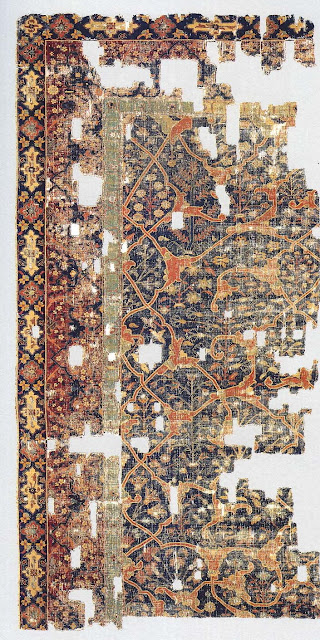 |
| 8-Christies 1999 |
 |
| 9-Purrmann Collection |
 |
| 10- reconstruction as a symmetric design |
 |
| 11-McMullan Collection |
 |
| 12-McMullan medallion reconstruction |
 |
| 13-The McMullan and V&A fragments |
Closely related to the Arabesque carpets are a further two groups featuring split-leaf arabesques, referred to here as the "Connected Medallions" Group and the "Vase-Lotus" Group. By chance two later Bijar carpets appeared together at Grogans Auction in 2021 demonstrating the two related but distinct styles.Such carpets were constructed in two distinct fashions: an orderly,professional method, and a rural style.For collectors the rural, " downhome " style is of greater interest: the professional type is noble floor-covering.Again, the starting point for these types can be seen in a somewhat later and simplified Vase-Carpet sold at the Bernheimer Sale which later reached the Farnham Collection after a modest tweaking at J.P Willborg.An earlier grander version was once in the Baranovicz Collection.
 |
| 14-Grogan 2021 |
 |
| 15-Bernheimer Christies 2010 |
 |
| 16-Baranowicz-Prather |
The Garrus Carpets have been divided here into seven clusters:
Group 1-The Split-Leaf Arabesque carpets with symmetrical field design;
Group 2-The Split-Leaf Arabesque carpets with asymmetric field design;
Group 3-The Arabesque carpets with connected medallion space;
Group 4-The Arabesque carpets with connected "Vase-Lotus";
Group 5- Carpets with the Garrus border,but with other field designs;
Group 6-Garrus Wagirehs,again divided into sub-groups;
Group 7- Garrus design carpets from other weaving areas,many woven in silk, and diverse other examples.
Group 1: The Split-Leaf Arabesque Carpets with symmetrical field design.
Immortalised by Annette Ittig in 1981, at least six large carpets with dates and inscriptions have been recorded.
Ist inscription:Wiltshire,Christies 1979: Ordered by his excellency Ali Riza Khan,Work of Garrus,1295/1878.
2nd inscription: "amal Garrus,1207" Both the G of Garrus and the second digit of the date have been subsequently altered.Sold at Christies in 1936 to Arditti for 70 guineas;later Henry Oppenheimer Collection;sold at Christies 24 April 1997 for 26,450 GBP.
3rd inscription, McMullan Collection/ MET: Ordered by his excellency Ali Riza Khan,work of Garrus,1209/1794(altered,date should be 1309/1891-2)
4th inscription: Worcester Art Museum/Viscountesss Rothermere: "By the order of His Excellency Emad Khaqan; Work of Garrus 1318/1900 A.D.Previously translated as "Work of Korus" due to a confusion between kaf and gaf in Farsi.
Sold at Christies New York on 6 December 1988,lot 172, for $ 29,700;again at Christies on 19 November 1992(146);unsold at Sothebys New York on 17 December 1999(237);unsold at Sothebys New York on 27 September 2000(168);unsold at Christies London on 8 October 2013(109); sold at Christies London on 7 October 2014 for GBP 15,000.
5th inscription,Tehran Museum carpet 1906:"Presented by the devoted slave General Haji Ali Riza Garrusi to the exalted presence,His Imperial majesty,Refuge of the faithful, Muzaffar al-Din Qajar-May our souls be sacrificed to him! 1324/1906" (Muzaffar died 1906)
6th Inscription,Maktabi:"Commissioned by Haj Ali Reza Khan Amir Toman and woven for the benefit of his daughter Mohtaram Khanom. Made in Garrus (in the year) 1328/1910".
If one and the same person, then Ali Rizza ordered carpets in Garrus between 1878 and 1910, which seems unlikely.It would be of value to know when he died.At least two of the dates have been tampered with. That the group as a whole stems from the late 19th century is not unlikely:the dating was simply a method of increasing value in the eyes of foreign buyers (dates and inscriptions probably became desirable after the discovery and promotion of the Ardabil carpet)The group is quite diverse with four long and two shorter carpets,and only the Maktabi rug has a standard Garrus border.The most well-known of all,the McMullan carpet, has been compared to the Bingham Strapwork carpet,also in the MET,yet the comparison seems superficial. The Vase carpet fragment of plate 8 is much closer.
 |
| 17-the dated Garrus carpets |
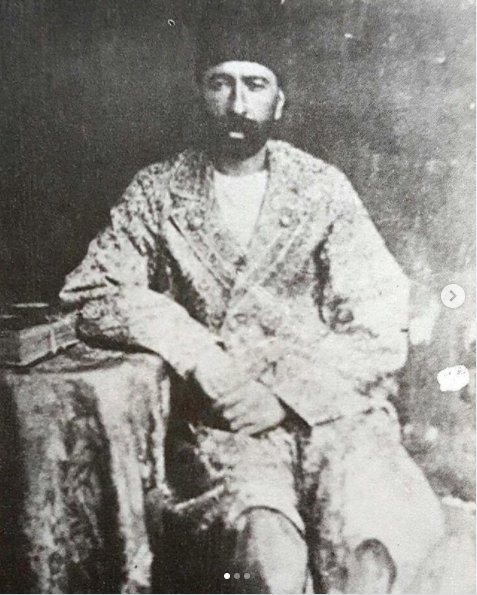 |
| 17a-Ali Reza Khan? |
 |
| 17b-The Bingham and McMullan carpets |
Group 1-The Split-Leaf Arabesque carpets with symmetrical field design(18-25c)
The symmetrical group with a green ground border form the core group(directly derived from the Tehran Salting)The border modulates between light green, blue-green and emerald. The abrash is clearly deliberate.Two basic styles are shown here:a more relaxed approach and a concentrated professional look.The Danker carpet once sold at Rippon Boswell is a real benchmark,as is the unfortunately reduced piece once at Sothebys in 1991.A particularly exorbitant model was at the Hans König Sale, Christies, in 2018.A carpet once with John Colllins has the distinction of being the only known example with four white ground arabesque borders.The symmetric group were also woven with red-ground borders, but these carpets are less convincing, perhaps from another time or place.
The Herati "turtle" border,quite common in Bijar weavings, was also used in Garrus.Here two relaxed examples(Rahmanan and Sothebys 1991) face off against two shriller pieces(Christies 1989 and a carpet at the Sedlin Sale, which is so awful as to be truly impressive)
 |
| 18-green Garrus border |
 |
| 19-green Garrus border |
 |
| 19a-with John Collins |
Plate 21a shows a small group with spiral-vine duktus encircling the lateral field.The large and longer carpets, such as a piece at Skinner in 2020, employ only a minimum border.Very large and imposing objects often feature a Herati(22) White-ground carpets are rare; the earliest publication was at the AAA in 1913.(22a)A white-ground arabesque wagireh has been recorded.
Two carpets with the white-ground arabesque borders are also noted here(23)A third example is included due to design similarities.All three are at a consistently high-level.
A large and remarkable carpet illustrated by John Collins shows an awkward but delightful faux-arabesque border.Two other examples have been recorded(24)
 |
| 20-symmetric arabesque with red-ground border |
 |
| 21-symmetric arabesque with Herati border |
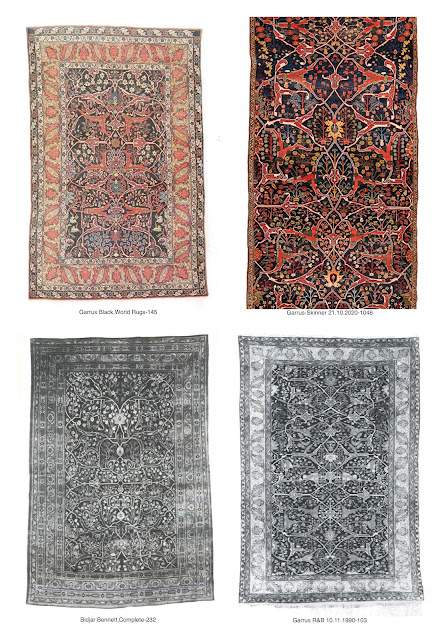 |
| 21a Spiral-Vine |
 |
| 22-Herati border,Skinners large size |
 |
| 22a-symmetric white-ground |
 |
| 23-two white arabesque border guards |
 |
| 24-arabesque borders |
 |
| 24a-John Collins-Oriental Rug Review 12-4 |
The "Chintamani" border,a borrowing from the Heriz area, can be seen here on two magnificent carpets.The arabesque design itself is said to have been woven first for an Azerbaijani General (25) The earliest publication seems to have been in Robinson II,1893-a painted reproduction without comment from the man who sold the Ardabil.(25a)
 |
| 25-Chintamani border |
 |
| 25a-Vincent Robinson, 1893 |
Clearly many other factions were at work weaving this design,some more or less succesfully. A border of meandering small palmette often came in handy (25b) An unusual blueground border on a carpet from Christies 1994 is classically derived. Also worthy of note is an item with cartouche border, at Sothebys in 1993(25c)
 |
| 25b-symmetric design,other borders |
 |
| 25c-symmetric design, other borders |
Group 2-The Split-Leaf Arabesque carpets with asymmetric field design.(26-29)
The most dramatic of the Garrus carpets are those with an "asymmetric" design. Only a section of the original is shown, in the same way as many Lotto carpets were woven.It is difficult to guess the size of these carpets from a photo, but here we enter the area of the "Wagireh-Style" carpet. These are pieces which have often been decribed as wagirehs or samplers,and were said to have been used as weaver`s aids, or for demonstration purposes.This seems unlikely as most of these carpets are often at least 2 x 3 mtrs, and even larger sizes are known.A weaver could not deal with such sizes as a work aid, for which smaller mats were available, and a sales person would have presented original carpets.It seems clear that the "Wagireh-Style" designs are complete carpets woven as a pars pro toto gag.Other types of Bijar carpets were also thus woven-a group of medallion-palmette carpets,for instance(26a) The iranian love of gardens is mirrored in such extreme examples(27)Some long carpets were also woven, including a stretched Wagireh-Style rug once at Sothebys in 2000(28)Again,such pieces were also woven with alternative border schemes (29)
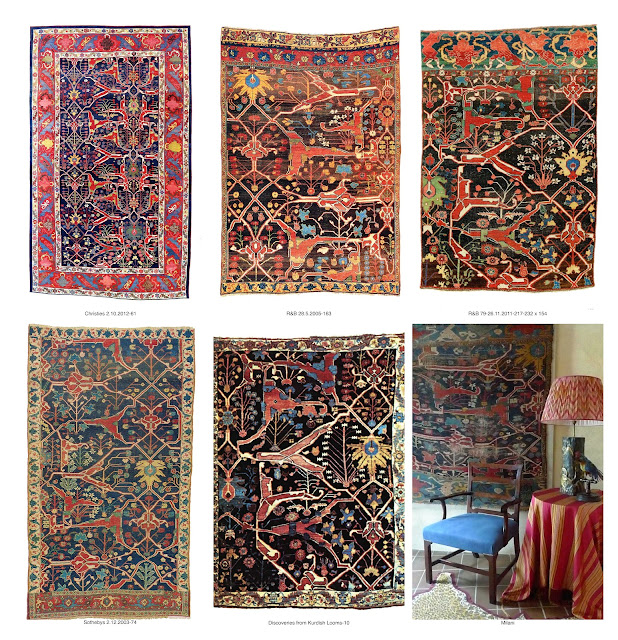 |
| 26-asymmetric design,Garrus border |
 |
| 26a-Bijar Palmette-Pendant group |
 |
| 27-asymmetric design,without border |
 |
| 28-Runners |
 |
| 29-asymmetric design,other borders |
Group 3-The Arabesque carpets with connected medallion space(30-40)
Through a skillful use of the arabesque these carpets create a repeat medallion form in the field.Depending on various levels of skill ( and perhaps sobriety) the simultaneity is sometimes lacking or over-apparent.An item at Sothebys in 2007 was described as "Khorasan" but is a clearly an aged member of the group, inspite of or depending on its condition(30) The weaving style is invariably kept simple,and the classic border occurs infrequently. In fact the group as a whole moves further and further away from the arabesque core group, although eccentric examples occasionally pop up. Blue-ground is standard; however an interesting white-ground piece at Sothebys in 1997 can be seen here (33) next to a factory-type Bijar as an informative comparison. On plate 35 the arabesques seem to break under the weight of a lush undergrowth and a remarkable photo-wash.Whereas in plate 36 the rinceaus appear to dissolve, in plate 37 they have been lined up in a soldierly manner, ready for market.The simpler rugs are much more attractive, as in the white-border group of plate 37. Majestic floor-covering is the chosen path on plate 38-such rugs are still very popular,especially in America.The soft,luscious tone re-appears for plate 39, and an eerie carpet from the Langlands in Australia is abitrarily placed here-there is nowhere else it fits.
 |
| 30-Sothebys Islamic 24 October 2007(400) |
 |
| 31-Arabesque connected medallion-complex style |
 |
| 32-"reformed" simple style |
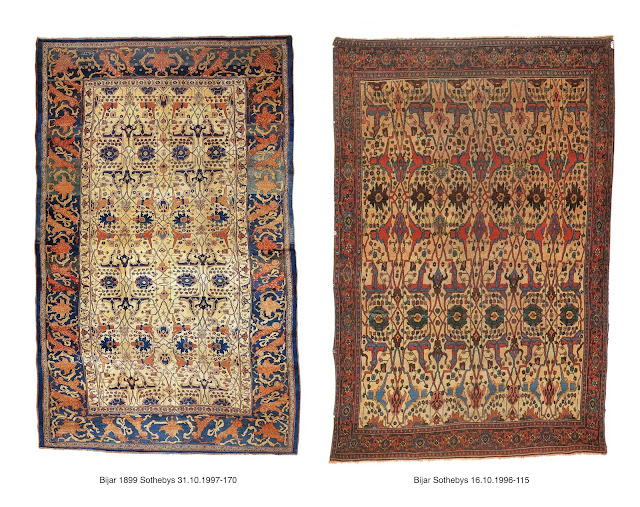 |
| 33-Garrus versus Bijar |
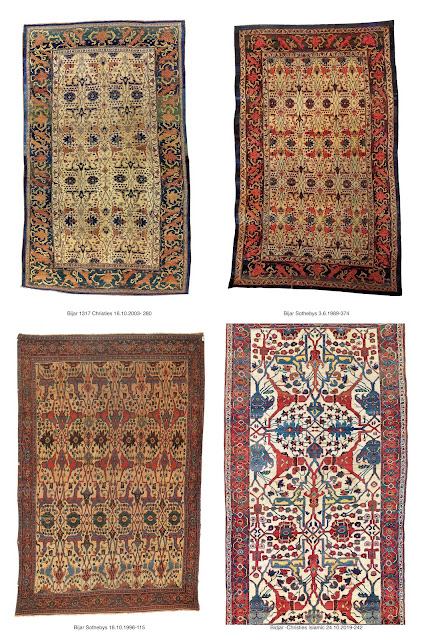 |
| 34-White-ground |
 |
| 35-before and after |
 |
| 36-simplified style with Garrus border |
 |
| 36a-White-ground border |
 |
| 37-White-ground border,wagireh style |
 |
| 38-ornate style |
 |
| 39-simplified style |
 |
| 40-from "Pathways Through Paradise" |
Group 4-The Arabesque carpets withe connected "Vase-Lotus" (41-55)
Group 5- Carpets with the Garrus border,but with other field designs.(56-62)
For this group a special device was invented,the "Vase-Lotus", a cross between the classical Vase design and a Lotus Palmette.It was formed by attaching fork-leaves to a schematised Lotus,thus forming a new "Split-Leaf Palmette" Swooping fork-leaves enshrine a further palmette, and the whole is lain over an endless flower-bed. As with all the designs from the area, there are simpler,rustic editions(41) and more complex(42) The simpler types frequently drift off into the wagireh zone(44) Others have an Arts & Crafts touch with white-ground borders(45)Some very complicated designs were woven with Polonaise-type winged palmettes(46) Yet another Persian William Morris was at work on plate 47, which shows the accompanying wagireh.Plates 50 and 51 demonstrate what was probably the original design,and elements of both types were integrated in plate 52. The final dissolution can be observed in plate 53, where a carpet once with Bausback suggests animal-combat forms. A group with frieze-panels in the wagireh mode appears in plates 54 and 55.Moving further away from the core group, carpets were also produced with an allover pattern of border designs(56) and simply with varying types of endless allover patterns(57-58a) Superb medallion carpets exist on plain grounds (59) and whimsical garden aggregates(60) Allover Quatrefoils were also a speciality, probably derived from the Vase Carpet assortment, such as the Adam Clayton example and its progenitor, the now lost Deering Vase Carpet(60b) Such classic models,as well as the Ardabil Salting, would not have been available in humble Bijar and indicate foreign intervention.The "Mustaphi" design, an import also woven in the Ferahan area, was employed using the standard Garrus border(61-62)
A quick look at the Grogan carpet pair reveals how closely these two designs interlock and were extricated from one another.
 |
| 41 |
 |
| 42 |
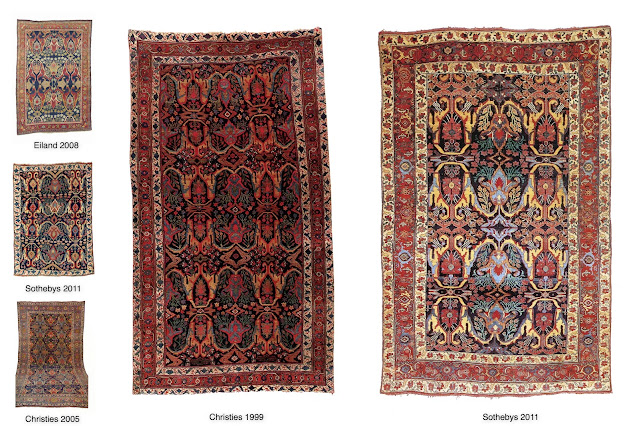 |
| 43 |
 |
| 44 |
 |
| 45 |
 |
| 46 |
 |
| 47 |
 |
| 50 |
 |
| 51 |
 |
| 52 |
 |
| 53 |
 |
| 54 |
 |
| 55 |
 |
| 56 |
 |
| 57 |
 |
| 58 |
 |
| 58a |
 |
| 59 |
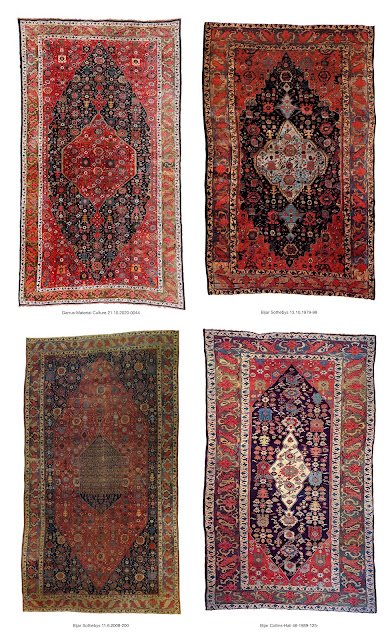 |
| 60 |
 |
| 60a |
 |
| 60b |
 |
| 61-Mustaphi design |
 |
| 61a |
 |
| 62 |
Group 6-Garrus Wagirehs,divided into sub-groups(63a-72)
The most delightful weavings from Garrus are the wagireh panels, whose possible use has already been mentioned.They appear to be a 19th century invention,perhaps born out of patchwork carpets assembled from classical fragments, such as the McMullan-V&A Vase carpet(63a)A remarkable carpet fragment,once with Galerie Neiriz in Berlin,is dated 1863/64 and dedicated to the Amir Nezam and signed "the work of Garrus" It depicts the ground-plan for a medallion carpet,the like of which does not exist-an "imaginary carpet" as so many wagirehs are(63b)A unique white-ground rug with an arabesque design was published by Herrmann,but had previously been illustrated by Erdmann in his reflexion on the genre.It seems to have belonged to Jacoby(64)Equally appealing are the blue-ground arabesque pieces, some of which pictured here are probably rug-size.The impact is heightened by omitting the border(65-66)The most outstanding wagireh carpet was sold at Rippon-Boswell in 1986 for $11,600(67)Two other rugs show a typical white-ground border(68) A brown-ground piece with Garrus border of notable elan was at Christies in 2017(69) Plate 70 serves to demonstrate how one carpet can alter its appearance with three different reproductions.An outstanding item with medallion on white-ground appeared at Christies in 2006, and seems to mimic the lay-out of a Triclinium or audience carpet(71) A rag-bag of items are shown for their remarkable versatility(72)
 |
| 63a |
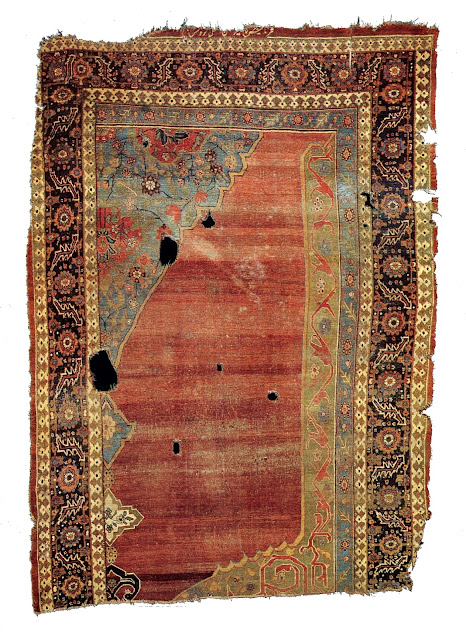 |
| 63b |
 |
| 64 |
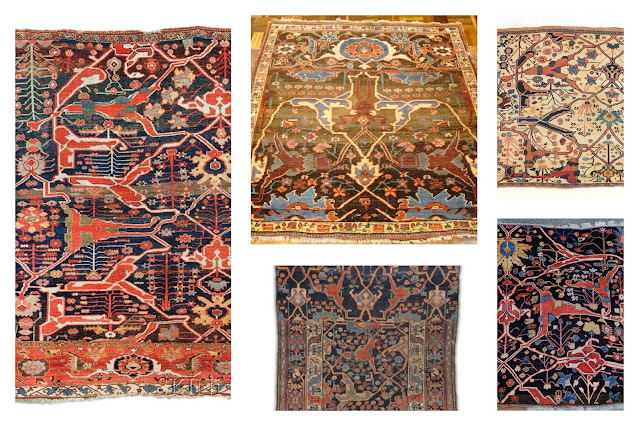 |
| 65 |
 |
| 66 |
 |
| 67 |
 |
| 68 |
 |
| 69 |
 |
| 70 |
 |
| 71 |
 |
| 72 |
Group 7- Garrus design carpets from other weaving areas.
Forked-leaves were sometimes lined up vertically on large carpets, chiefly for people who never looked at the floor(73) A wagireh-style carpet with prayer component was published by Alberto Levi in 2002 and later sold at Christies in 2005 for $7200.It is the only rug of this type with prayer niche recorded here.A number of silk rugs have been recorded,including two which are probably from the area itself,or from Greater Bijar(74) Kashan and Tehran versions in silk were also produced(75-77)Woolen examples from Tabriz are also known:plate 80 shows a Tabriz and a Garrus edition of what is basically the same design. It seems unlikely that the Tabriz carpet is a cleaned-up version of the Garrus; rather the opposite is true-the Garrus is a zany creation developed out of the Tabriz manufactory.Thus it might be that the Garrus carpets were produced by Tabriz manufacturers outsourcing their labour to the Bijar area, where a plentiful supply of resources was at hand,including some of the best natural dyes in Persia, and much cheap and highly-skilled labour.The choice of the Ardabil Salting carpet and other classical models indicates a shrewd knowledge of the great Persian tradition,at a time when such objects were known only to a small circle.Perhaps the Azeri community in Garrus were the protagonist weavers,and with the time the simpler styles developed which could be produced as a cottage industry.Even today the town of Yasukand in Bijar County is said to be chiefly inhabited by Azeri Turks.And lastly one should not forget the legend concerning the Azerbaijani General for whom the design is said to have been first created:the Sardar Aziz Khan-hence "tereh Sardar" or design(Mumford,page 75)Little importance should be attached to the signed and dated examples:they were probably produced to confuse the Gringos.
 |
| 73 |
 |
| 73a |
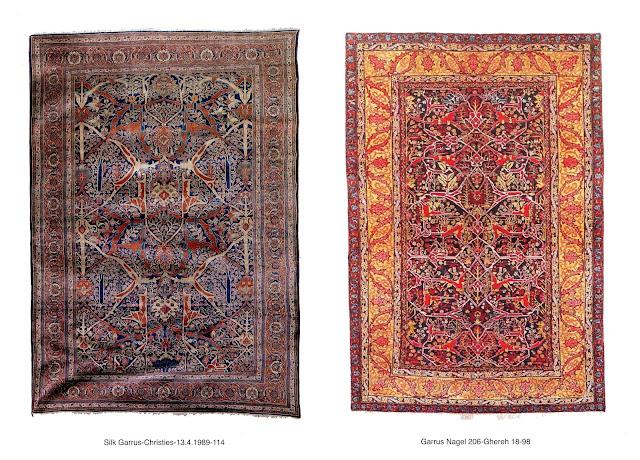 |
| 74 |
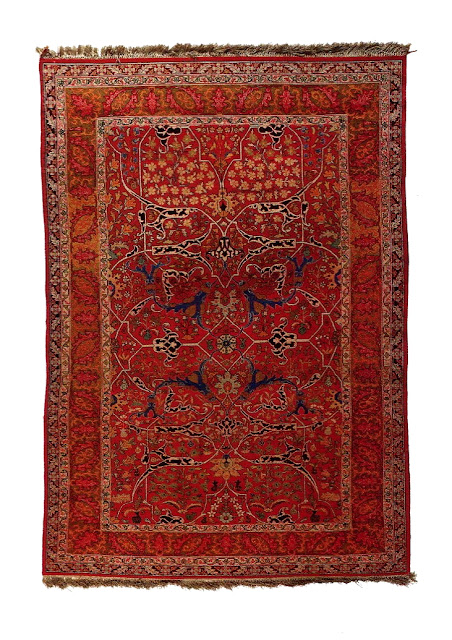 |
| 75 |
 |
| 76 |
 |
| 77 |
 |
| 78 |
 |
| 79 |
 |
| 80 |
 |
| 81-James D. Burns Collection |































































































